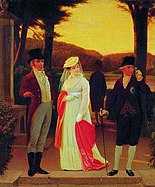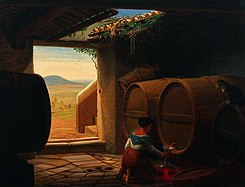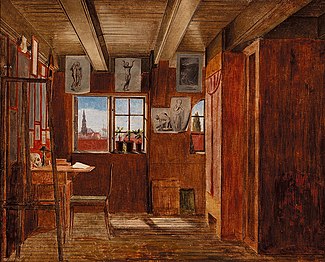Hans Jørgen Hammer

photo: Budtz Müller Studio
Hans Jørgen Hammer (29 December 1815 – 28 January 1882) was a
. In addition, he served for eleven years as a military officer.Biography
Hans Jørgen Hammer was born in Copenhagen to Johanne (née Bistrup) and Peder Pedersen Hammer, a shipmaster. A younger brother, William Hammer (1821–1889), also became a painter. As a boy Hammer displayed an aptitude for drawing, and he received his first training from the Norwegian-Danish master Jon Gulsen Berg (1783–1864), a court painter and wallpaper designer.
Hammer was admitted to the
Hammer's career was interrupted in 1848 by the outbreak of Denmark's Three Years' War with Prussia over hegemony in the Duchy of Schleswig. He volunteered and was commissioned as a naval ship-of-the-line lieutenant in March 1849. In the years following Denmark's fragile victory, he remained on active duty with the rank of captain before shifting to the reserves and finally leaving the service entirely in 1860.
Prior to the war Hammer had been encouraged to apply for a stipend to cover the expense of a sojourn in Italy, and finally at the age of 41 he traveled there with the financial support of the Academy of Fine Arts. The paintings he produced in Italy in 1856–57 and immediately thereafter had considerable public appeal. A Square in Ariccia after Sunset (1862) with its striking coloration was highly praised and purchased for the Royal Painting Collection. Highlights among his later works are Den lille Axsamlerske (1866) and The Postman with the Long-Awaited Letter (1877). He delved into national history with Jens Baggesen and Count Schimmelmann (1872, painted in two copies) and Count Gert and Niels Ebbesen (unfinished, despite extensive preparatory studies), and he also illustrated works of Hans Christian Andersen, Adam Oehlenschläger, and Christian Winther.
In 1862 he was decorated a knight of the Order of the Dannebrog, and in 1874 he was named a member of the Academy of Fine Arts. He traveled to the United States in 1874–75 to visit relatives and also visited Skagen in 1875, painting motifs in both locales. He also traveled to the Centennial Exposition in Philadelphia in 1876. He was decorated a knight of the Order of St. Olav in 1877 and was awarded a travel stipend from the Carl Andreas Anker Legacy in 1879. Hammer came close to dying of anemia, but he recovered and was able to travel to Italy for a second time in 1881–82. That winter he caught a cold and succumbed to fever, and he is buried in Rome's Protestant Cemetery. Hammer, who never married, was described by contemporary art historian Philip Weilbach as serious, diligent, and thoughtful, but also somewhat labored and tentative. A perfectionist streak is said to have curtailed his productivity and hampered his creativity.[1][2]
His likeness is preserved in a portrait by Constantin Hansen (1863), a woodcut after a Bertel Christian Budtz Müller studio photograph, and various self-portraits, including one drawn in pencil and held by the Frederiksborg Museum. A number of his drawings and engravings are held by the Royal Collection of Graphic Art, the ARoS Aarhus Kunstmuseum, the Roskilde Museum, the Randers Museum of Art, the Vejle Museum of Art, and the Museet på Koldinghus. His paintings are in the Fuglsang Art Museum on Lolland, the Bornholm Art Museum, the Sorø Art Museum, the Museum of Modern Art in Aalborg and, in Copenhagen, in the National Gallery, the Hirschsprung Collection, the Rosenborg Collections, the City Museum, and the M/S Maritime Museum of Denmark.
Gallery
- Danish Motifs
-
Farmers Return Home from the Field with the Final Sheaves of Grain (1845)
-
Farmboys and Girls Gather for Outdoor Merrymaking on a Holiday Afternoon (1847)
-
Farmhouse Interior
(undated) -
Market Day in Fredericia
(undated) -
Baggesen and Schimmelmann (1872)
- Italian Motifs
-
View of Rome from the Artist's Dwelling
(1858) -
Coastal Landscape
(1858) -
Woman Tapping Red Wine
(undated) -
Motif from Italy with Monks
(undated) -
A Square in Ariccia after Sunset
(1862)
- Studio Motifs
-
Study of a Young Male Model with a Branch in His Hand (1843)
-
The Artist's Studio in Nyhavn Overlooking Christian's Church and a Ship on the Canal (undated)
-
Girl with Slippers – Model Study of Madam Hack (1843)
References
- ^ a b Hanne Jönsson, C. W. Eckersberg og hans elever. Udstilling i anledning af 200 året for kunstnerens fodsel (Copenhagen: Statens Museum for Kunst, 1983), p. 100 (in Danish). See also the English summary: Lars Rostrup Boyesen, C. W. Eckersberg and His Pupils (Copenhagen: Royal Museum of Fine Arts, 1984).
- ^ Philip Weilbach, "Hammer, Hans Jørgen". In Dansk biografisk leksikon, ed. Carl Frederik Bricka (Copenhagen: Gyldendal, 1887–1905), vol. 6, pp. 531–532 (in Danish). Excerpted from Philip Weilbach, Nyt Dansk Kunstnerleksikon (1896–97) (in Danish).
External links
Peter Nørgaard Larsen, "H. J. Hammer", Kunstindeks Danmark (in Danish).
Hammer's gravestone in Rome's Protestant Cemetery













